|
 Preparation Preparation
Mgay Bari is an important
moment for the Truku to pay respects to
their ancestral spirits. We have interviewed
Mr. En-ma, who has been the priest
responsible for the Truku’s Mgay Bari for
many times. He reminded us of several things
we must be aware of in Mgay Bari.
In Mgay Bari, tribe
members must be very peaceful in heart; they
must not fight or quarrel in the tribe, for
otherwise, the prayer to heaven for the
peace and abundant harvests in the coming
year will fail.Director
Kaji also said that the sacrifices are holy.
Bad lucks will come if they are touched by
people other than the priests, so ordinary
people must not touch them.
【Text
by Yu-bo Wen, Teacher Shu-jun Hua】
References:
1. An Interview with the elder Mr. En-ma at
Tonglan Village in Shioulin Township, Hualien
County, on January 4, 2008.
2. An Interview with the local cultural worker
Mr. Kaji at Fushi Elementary School in Shioulin
Township, Hualien County, on January 25, 2008.

 Procedure
of the Ritual Procedure
of the Ritual
1. Decoration of Houses of
Tradition
Each tribe that joins the
ritual site has a house of tradition. These
houses of tradition will be decorated by each
tribe with millet, maize, and wild boar bones,
etc. symbolizing an abundant harvest.
2. Mgay Bari Discussion
Chief of each tribe will be richly dressed and
equipped with a hunting knife or a lance; they
will go to the residence of the supreme chief
and shout, and sit in a circle to discuss.
3. Hunting Teams’ Return with
Lots of Prey
After five to six days of hunting, the hunting
team from each tribe will return with lots of
prey, and shout for their victory near their
home.
4. Sharing of Prey
The preys obtained by hunting teams will be
butchered together and distributed by chiefs.
Small pieces of meats cut from a prey’s head,
tail and foot fingers will be wrapped with
Alpinia leaves as sacrifices.
5. Mgay Bari
After the site is prepared, each tribe will have
several males and females holding sacrifices and
led by the supreme chief, priests, elders, and
tribal chief to the site. Priests will be
responsible for everything in the ritual: the
summoning of grandfathers and grandmothers,
fathers and mothers, praying to ancestor spirits
for protections of tribe members, chanting
ritual oration, and placing the sacrifices
wrapped in Alpinia leaves in the wild for the
ancestral spirits’ consumption.
6. Festival and Gratitude for
Ancestral Spirits
After the ritual, the supreme chief will
lead people sing and dance together. Each family
will bring alcohols and foods to the square in
front of their tribal chief’s residence to share
with each other. Besides expressing gratitude
for ancestral spirit’s protections, they will
also pray for the peace and prosperity of the
coming year.
References:
1. Kaiji, C(2004) “Impromptu and Transcence:
Rituals and Images of Ancestral Spirits of
Seejiq Truku villages”. Master’s thesis,
Graduate Institute of Anthropology, Tzu Chi
University.

 Mgay
Bari Songs Mgay
Bari Songs
Imi Yudaw spares no effort in
preserving traditional culture. Since 1974, she
has been collecting Truku traditional songs and
dances for about 40 years. She traveled to
mountain regions of Hualien and Nantou,
interviewed Truku elders. In many of nowadays’
Truku traditional dancing performances, dance
music arranged by Yudaw are used. She is a
master in traditional Truku dance and music.
Truku music mainly uses the four notes of
Re, Mi, Sol, La. Xylophones, reed-harmonica,
wooden drum, and head-hunting flutes are the
Truku’s traditional instruments. In rituals or
festivals, members will bring their own
instrument to play collectively or solo.
The following songs often appear in rituals and
festivals, lyrics are Romanized Truku.

Uyas Smapuh Tmukuy (Songs of Seeding Ritual)

Uyas Smapuh Tmukuy (Songs of Seeding Ritual)
Title:
Songs of Seeding Ritual Lyrics: Baki
Saydang, Arranger:
Imi Yudaw
Summary: Traditionally, the Truku must pray to
ancestral spirits for fortune before seeding. A
lucky day in February or March will be picked
each year. On this day, a priest will take all
the seeds to the prepared alter in a deep
mountain field to pray at 3 am, to ancestral
spirits for protection and abundant harvests.
What this song says is that millet is our
primary food, and we do not usually use beans or
glutinous rice. We also pray to ancestral
spirits for abundances in harvest.

Uyas Gmluk Ghak (Rush-Planting Song)

Uyas Gmluk Ghak (Rush-Planting Song)
Title:
Rush-Planting Song
Lyrics:
Baki Saydang, Arranger: Imi Yudaw
Summary:
After the priests finish the ritual, s/he will
bring all the seeds from the ritual back to the
members for seeding. Usually, seeds that have
been blessed by the ritual will be matured well
and abundantly. Therefore, tribe members will
try to seize these seeds and plant them by
female members.

Uyas
Tmukuy (Seeding Song)

Uyas
Tmukuy (Seeding Song)
Title:
Seeding Song
Arranger : Collected
by Imi Yudaw .
Summary: People seize the blessed seeds and
plant them with their own seeds in their fields.
Look! Women must hold their arms very high to
spread the seeds evenly to the whole field; they
go home after they finish.

Uyas
Kmtuy Masu (Harvesting
Song)

Uyas
Kmtuy Masu (Harvesting
Song)
Title:
Harvesting Song
Arranger:
Collected by Imi Yudaw
Summary: When matured, those millets must be
harvested. Conventionally, tribe members must
not talk to each other in the harvesting. They
must harvest them in certain order. These big
millets matured beautifully; a tassel by a
tassel, the harvests must have increased. Go
home after the harvesting is finished.

Uyas Mangal Masu
(Song of Harvests)

Uyas
Mangal Masu (Song of
Harvests)
Title:
Song of Harvests Lyrics:
Imi Yudaw,Composer:
PayiTumum from Chongde
Village
Summary: This song is for the celebration of a
harvest. Whether a harvest of the year is good
or bad depends on Heaven, no one can tell. But
since it is a rare chance, we should drink,
dance, and be happy together.

Uyas Smlayiq Mtkatang (Song of the Ritual of
Peace)

Uyas
Smlayiq Mtkatang (Song of the Ritual of Peace)
Title:
Song of the Ritual of Peace
Arranger:
Collected by Imi Yudaw
Summary: In the past, people will pray to
ancestral spirits for fortune and spiritual
power before they set out to head hunt, in order
to accomplish the mission successfully. What
this song says is that they hope the head
hunters, due to their outstanding conditions,
can return without any injury like clear water.

Uyas
Kbhug
(Song of Hero)

Uyas
Kbhug (Song of Hero)
Title:
Song of Hero
Arranger: Collected by Imi Yudaw
Summary: A hero for the Truku, especially a head
hunter, is the most lawful, righteous member in
the tribe who is also very fierce, brave,
strong, and professional in martial arts. A hero
is also a man of great heroism and prestige, who
can travel through mountains, rivers, and thorny
paths without fear of any difficulty.

Uyas Smapuh Tunux Song of Head Sacrifice

Uyas
Smapuh Tunux Song of Head Sacrifice
Title:
Song of Head Sacrifice Arranger:
Collected by Imi Yudaw
Summary: When a hero returns home, a priest will
put the head on a stand and perform the
sacrificial ritual. The lyrics of the song state
that we spent a lot of effort to obtain you; we
believe that your family is very sad, but we
will give you a lot of sacrifice, so we hope
your ancestors, brothers and sisters can also
come.

Uyas
Smqaras (Song of Celebration)

Uyas
Smqaras (Song of Celebration)
Title: Song of
Celebration Arranger: Collected by Imi
Yudaw.
Summary: When a hero returns, all members of the
tribe will gather at the hero’s home to
celebrate, drink and dance, to express their
appreciation. If the hero is young, he can also
marry, having a double blessing

【Music
produced by: Teacher Guan-ting Lin; Text by
Teacher De-lin Ai, Teacher Shu-jun Hua】
Source:
Edited by Hu, C.H. (Date
unknown).
Traditional Songs of the Seejiq Truku in
Hualien County, vol. I. Hualien County
Taroko Construction Association.
 The
Mgay Bari Dance The
Mgay Bari Dance
Recently the Truku renamed
the “Ritual of Ancestral Spirits” as “Mgay
Bari”. They also have “Weaving Ritual”, “Hunting
Ritual”, and “Harvest Ritual”.
Nowadays, every townships
hold ritual activities not only to increase the
cohesion of their tribe, but also to attract
tourist and promote their tribal industries and
cultural assets. Therefore, in a ritual, besides
solemn ritual activities, there will be also
traditional interesting competitions, such as
trap-setting, boar-catching, archery, wrestling,
wood-sawing, burden relay race, wood-chopping,
weaving, rice-husking, and traditional cuisines,
etc.
In this dance “The Truku Happily Celebrate a
Harvest”, the happy annual Truku celebration of
a harvest is shown.
【Songs
Details】
1.The
First Phrase:
Ritual Activities:
1-1
Duration:
1 min 20 sec
1-2
Method of Performance: 5 xylophones and 1 wooden
drum. This is an instrumental collected and
arranged by Mr. Guan-ting Lin.
1-3
Interpretation of the
Content:
The
chief calls upon the young men in the tribe to
prepare for the Mgay Bari, for now is the
harvest season!
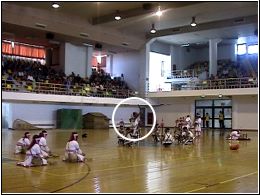 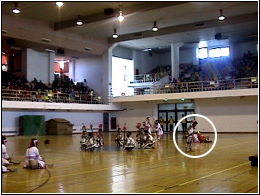
Hunters will gather at the
square and wait for the hunting.
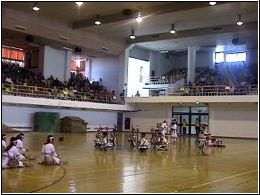 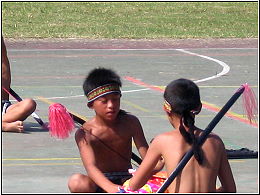
Before the hunting team set
out, the priest will hold up the sacrifice
(chicken).
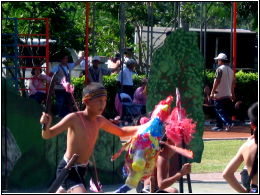
After the priest killed the
sacrifice, he will hold it across the hunters,
hoping that ancestral spirits will bless them
with fortune and courage. The priest will then
treat the blood of the sacrifice on the
fighters’ weapon (lances).

If a red sign
appears on the point of a weapon, they believe,
every member of the team will return with a lot
of prey.
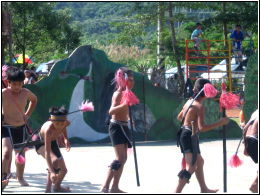
In the meantime, women in the
tribe will also busy preparing the activities
for Mgay Bari: some will husk rice assiduously,
some will weave attentively, and others will
play inspiring tunes with xylophones to inform
people with the success of the hunting team.
 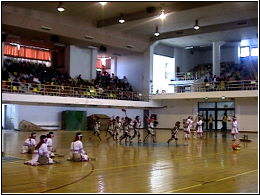
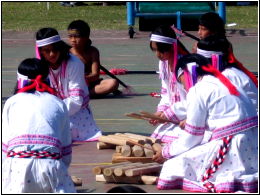
1-1
Duration:
6 mins :
30 sec.
1-2
Method of Performance:
Play with CD. Source: produced by Bideluo.Wuga,
Title:
Let’s dance!
1-3
Interpretation of the
Content:
After Mgay Bari, members of the tribe will
celebrate the abundant harvest, and traditional
competitions will also be held.
 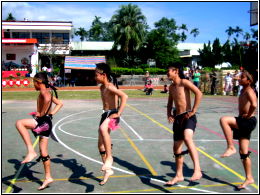
Activities for males
include: archery, wrestling, wood-chopping,
dance by males and females together to express
their feeling, reed-harmonica playing, Shanqiang
dance.
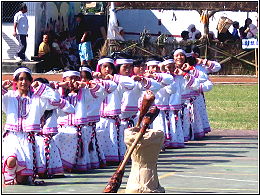 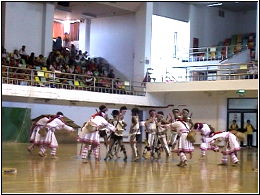
Activities for females include: weaving, cotton
spinning, filtering weeds with sieves,
reed-harmonica playing, and waist-accessories
flinging.
References:
Taroko
National Park website,
http://www.taroko.gov.tw/HistoryCulture/4_2_2_4/Default.aspx
 |